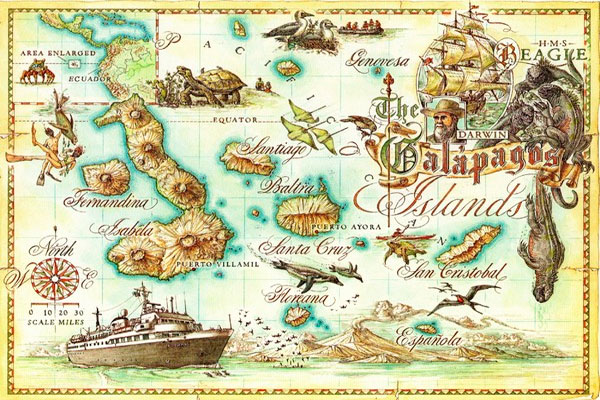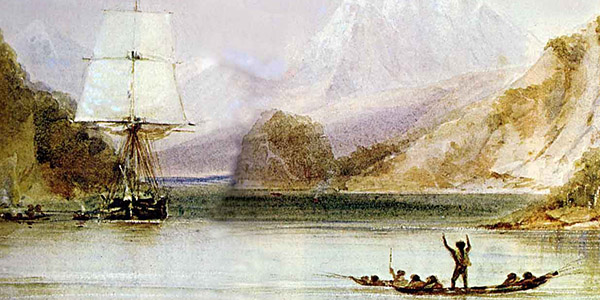Galapagos Islands History.

The Galapagos Islands were discovered by chance in 1535 by Fray Tomás de Berlanga. They became famous after Charles Darwin’s visit in 1835.
The Galapagos Islands lie in the Pacific Ocean, about 600 miles west of Ecuador. They are renowned for their unique wildlife and landscapes. Charles Darwin’s observations here contributed to his theory of evolution by natural selection. The islands’ volcanic origins and isolated location create a distinct ecosystem.
Tourism and scientific research thrive, promoting conservation efforts. The Galapagos are a UNESCO World Heritage site, attracting nature enthusiasts globally. Conservation remains vital to protect this natural wonder. Visitors experience close encounters with diverse species, making it a top destination for eco-tourism. The islands’ history and natural beauty captivate all who visit.
Discovery
The Galapagos Islands are a unique and fascinating place. Their history is rich with tales of discovery, exploration, and wonder. The islands were unknown to the world until the 16th century. The discovery opened a new chapter in the understanding of nature and evolution.
Early Explorers
In 1535, Bishop Tomás de Berlanga, from Panama, was the first to record the islands. He was on his way to Peru but drifted off course. He described the islands as barren and uninhabited. The discovery was accidental, yet it marked the beginning of a new era.
Spanish explorers continued to visit the islands. They named the islands “Las Encantadas,” meaning “The Enchanted.” They believed the islands had magical qualities because of the shifting currents and mists. Early maps and records from these explorers provided valuable information.
First Maps
The first detailed maps of the Galapagos Islands were created in the late 16th century. These maps were essential for navigation and exploration. They showed the islands’ locations and some key features.
By the 17th century, pirates and whalers also started using these maps. The Galapagos Islands became a hideout and a source of fresh water and food. The maps improved over time, helping more explorers reach the islands.
| Year | Explorer | Contribution |
|---|---|---|
| 1535 | Bishop Tomás de Berlanga | First recorded discovery |
| 1570 | Gerardus Mercator | First detailed map |
| 17th Century | Various Pirates and Whalers | Improved maps and navigation |

Credit: www.visitgalapagos.travel
Colonization
The Galapagos Islands are famous for their unique wildlife. But the islands also have a rich history of colonization. Let’s explore how settlers came and their impact on the islands.
Settlers Arrive
The first permanent settlers arrived on the Galapagos Islands in the early 19th century. These settlers came from Ecuador. They were looking for new land and opportunities. They established small communities on the islands. These early settlers faced many challenges. The harsh climate and rough terrain made life difficult.
Over time, more settlers arrived. They brought with them new animals and plants. These new species began to change the islands’ ecosystem. By the end of the 19th century, the human population on the islands had grown significantly.
Impact On Wildlife
The arrival of settlers had a big impact on the Galapagos wildlife. New animals like goats, pigs, and rats were introduced. These animals competed with native species for food and space. They also preyed on native animals. This led to a decline in some native species.
Settlers also introduced new plants. These plants often grew quickly and spread across the islands. They competed with native plants for resources. Some native plants became rare or even extinct because of this. The settlers’ activities also led to habitat destruction. Forests were cleared for farming and settlements.
| Impact | Description |
|---|---|
| New Animals | Introduced species competed with natives. |
| New Plants | Competed with native plants, causing some to go extinct. |
| Habitat Destruction | Forests cleared for farming and settlements. |
Despite these challenges, the Galapagos Islands remain a unique place. Efforts are now underway to protect and restore their natural beauty.
Scientific Research
The Galapagos Islands have been a focal point for scientific research for many years. These unique islands offer insights into the natural world. Researchers study the islands to learn about species and ecosystems.
Charles Darwin
One of the most famous researchers is Charles Darwin. He visited the islands in 1835. Darwin observed the diverse wildlife. His observations led to groundbreaking theories.
Darwin noticed differences in finches. Each island had its own unique species. This fascinated him and spurred his curiosity. His work on the Galapagos laid the foundation for his theory of natural selection.
Evolutionary Studies
The Galapagos Islands are a living laboratory for evolutionary studies. Scientists continue to study species here. They observe how animals and plants adapt. This helps us understand evolution better.
Researchers focus on several key areas:
- Species adaptation
- Natural selection
- Environmental changes
These studies provide valuable data. They help explain how life evolves over time. The Galapagos Islands remain a vital research site for evolutionary biology.

Credit: galapagosinsiders.com
Conservation Efforts
The Galapagos Islands are famous for their unique biodiversity. Ensuring the protection of these islands has been a priority. Conservation efforts here have a rich history. They aim to preserve both flora and fauna.
National Park Establishment
The Galapagos National Park was established in 1959. This was a significant step in protecting the islands. The park covers 97% of the land area. It safeguards the habitats of many species.
In 1978, UNESCO declared the Galapagos a World Heritage Site. This designation highlighted the global importance of the islands. It also brought more international attention to conservation.
Several key measures were introduced:
- Restricted access to sensitive areas
- Stricter regulations for tourism
- Programs to control invasive species
Modern Challenges
Despite these efforts, the Galapagos face modern challenges. Increasing tourism puts pressure on natural resources. The islands see more visitors each year.
Invasive species also pose a threat. Non-native plants and animals disrupt local ecosystems. Efforts to control these species are ongoing.
Climate change impacts the islands too. Rising temperatures affect marine and terrestrial life. Conservation strategies now include:
- Monitoring climate impacts
- Enhancing local community involvement
- Promoting sustainable tourism practices
The Galapagos Islands’ history of conservation is rich and ongoing. Protecting this unique ecosystem remains crucial.

Credit: www.nathab.com
Frequently Asked Questions
What Is The Origin Of The Galapagos Islands?
The Galapagos Islands formed from volcanic activity millions of years ago.
Who Discovered The Galapagos Islands?
Fray Tomás de Berlanga discovered the islands in 1535.
Why Are The Galapagos Islands Famous?
They are famous for their unique biodiversity and influence on Charles Darwin’s theory of evolution.
How Did The Galapagos Get Their Name?
The name comes from the old Spanish word for tortoises, “galápagos,” referring to the giant tortoises there.
Conclusion
The Galapagos Islands’ history is rich and fascinating. From ancient explorers to modern conservation efforts, it’s unique. Visiting these islands offers a glimpse into a world shaped by time and nature. Embrace the adventure and discover why the Galapagos remains an unparalleled treasure.
Plan your trip and witness history come alive.


